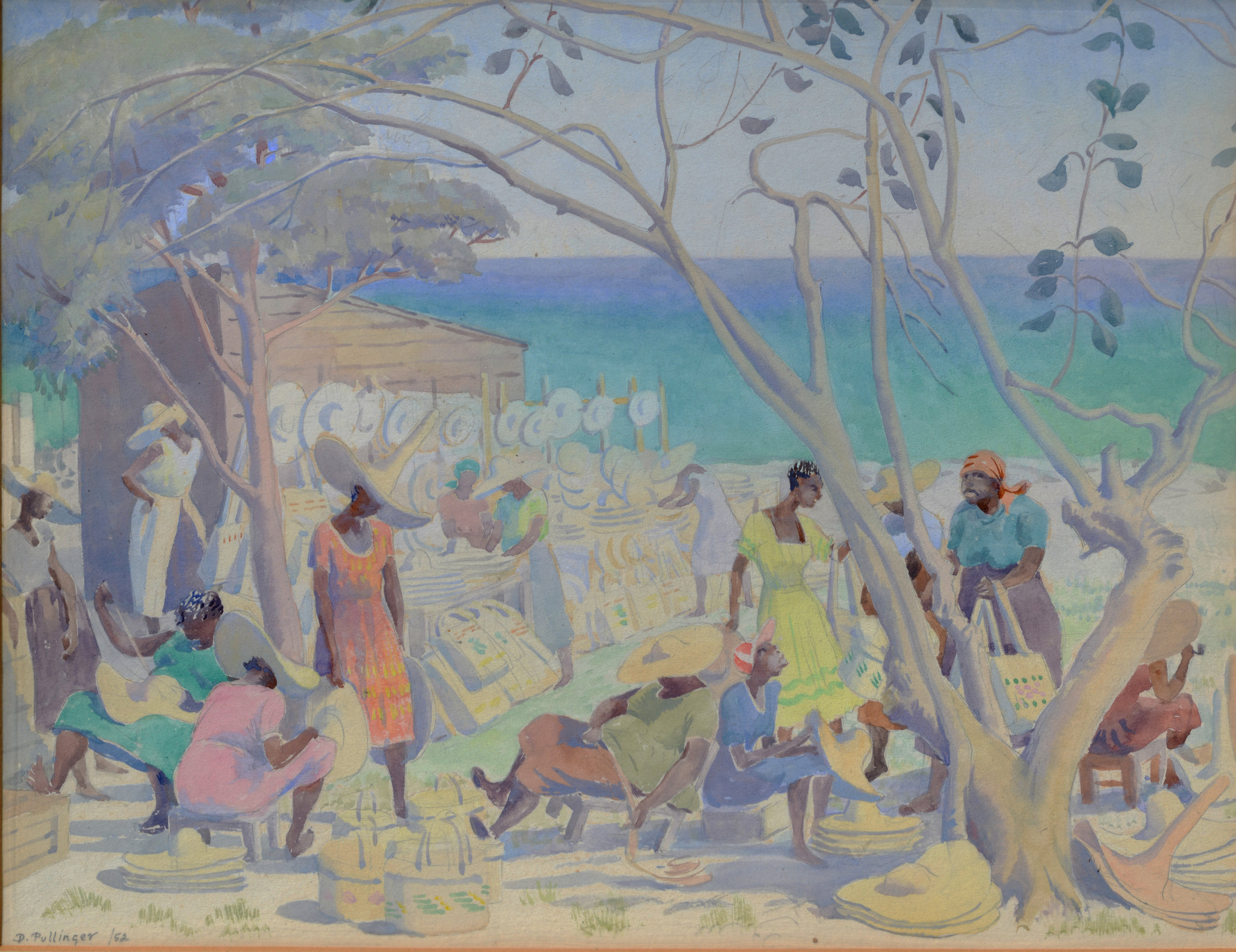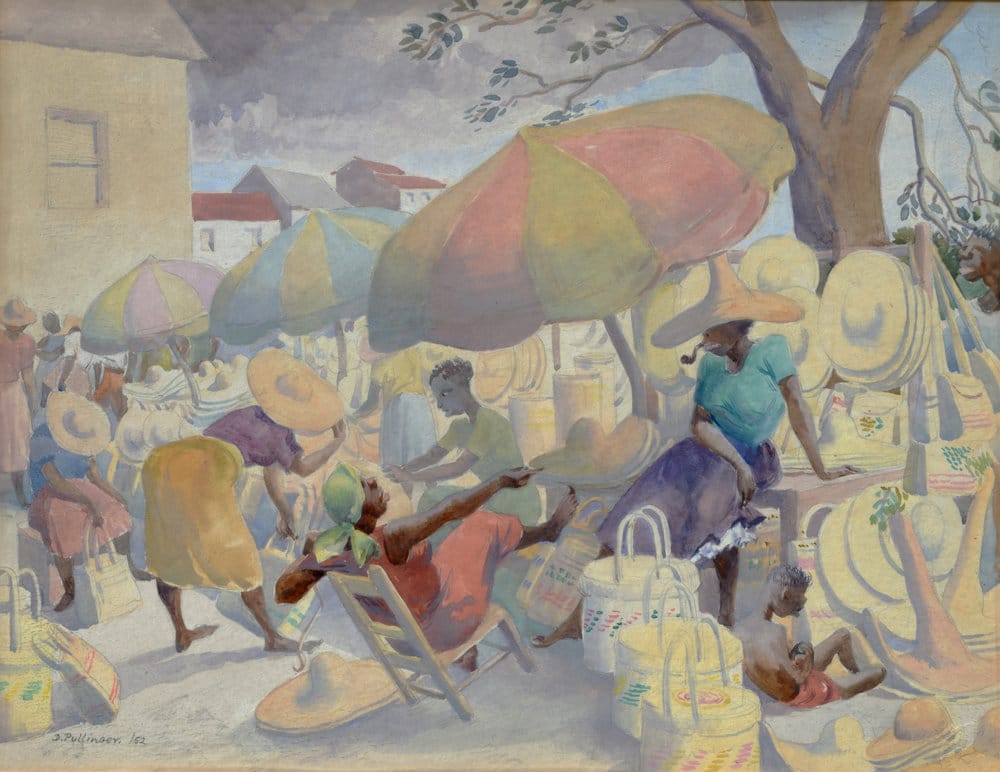
Dr Ian Bethell-Bennett
Paradise is beautiful. A space filled with art, colour, diversity, pleasure, and adventure. Paradise has become synonymous with the Caribbean and the Pacific. Paul Gauguin’s life and work encapsulate this paradise myth, as we clarified inthe recently published book Gauguin’s Challenge: New Perspectives After Postmodernism (Bloomsbury Visual Arts, 2018), as does the stunning landscape painting show, currently on view at the NAGB through the end of July

Market Scene (1952). Diane Pullinger, watercolour on paper, 10 ½ 13 1/2. Image courtesy of the Dawn Davies Collection.
So much of our lives, loves and struggles are caught up in, wrapped around and deep-fried in the paradise myth. We understand the beauty and the tragedy of where we live and how we live, but today, there seems to be a widening gap between how we manage this new kind of gentrification of paradise.Culture becomes a legacy that either survives or is consumed by the struggle for definition.
The eye of the beholder is always in awe of the Caribbean space as it stands apart from other spaces and places. Paradise is a myth constructed on reality as beaches, jungles, rivers, pristine coral reefs stretch for days into the horizons. It is much like the legendary pleasure dome in the mythical city of Xanadu, built by Kubla Khan, in Samuel Taylor Coleridge’s poem (1797/1816). Yet paradise is also a real place; there is Paradise Island in The Bahamas; there was/is Paradise Beach on Barbados, there is Paradise Found, the projected resort on Barbuda; and there are mini-paradises in many different destinations.
The complexity about paradise is that it is untouched and yet lived in. We see the beauty but we, as inhabitants, want more. We are caught between the myth and the reality of paradise. We also fall victim to paradise failure, as well as its success. Art and music, along with culture, all speak to the beauty and allure of paradise.
They show the blues, pinks, whites and reds, as sun rises in the morning and sets in the evenings, so too does the reflection across the water as the light shifts and changes. Our water brings healing to those who visit, as they flee dark, frozen northern months. They arrive into a mythical space of intensity, fecundity and natural over-stimulation, according to some critics, where the light is too much, the sex is too much and the rum is always flowing.
Ernest Hemingway lived this paradise, as did Gauguin, the characters in Graham Greene’s Our Man in Havana (1958) and The Comedians (1966), that Howard French discusses in The New York Times (27th April, 1991) on the occasion of its author’s death. Hunter S. Thompson’s The Rum Diary (1998) is a far less ‘glowing,’ though certainly colourful, picture of paradise on Puerto Rico.
In Mexico, there are a number of paradise spots, one was Playa del Carmen prior to exploitation of the late 1990s and early 2000s; now this paradise of untouched beauty has been overrun.Then there was Isla Mujeres, another quaint and unique site where the life is laid back and the sea is the way people live. The travesty of paradise is that it is usually developed at the expense of those who live there. The other tragedy or problem of paradise is that it starts small and then becomes a victim of its own success.
Isla Mujeres and Playa del Carmen no longer even vaguely resemble their past paradisal splendor. Overexposure and unbridled development have ravaged the land and the lifestyle—the culture. As soon as paradise finds this reality, those who come to find paradise move on. They want the next untouched destination. But surely they realise that each time they find the next untouched destination, once they touch it, they destroy its paradisal charm?
Merida in Mexico’s Yucatan Peninsula has seemingly managed this process well, holding on to squares, plazas, cafés, yet scorching hot streets and incredible architecture from a bygone age. Sometimes, art, life and pending change intersect, other times they collide, we seem to be at a juncture where the collision can be devastative or the intersection can be smooth, but we cannot be outsider bystanders looking in at the paradise myth.

Umbrellas (1952). Diane Pullinger, watercolour on paper, 10 ½ 13 1/2. Image courtesy of the Dawn Davies Collection.
The Caribbean has fallen victim to this very successful development. Over the last two decades, land has been lost from the Commons into the hands of private developers, who offer dreams of success as they pave over paradise and throw up multi-story high rises on little infrastructure. The old canvas of open, shores, deserted unbound beaches, sloops, land and seascapes are slipping away. We see the local folk losing their land as a natural way of building paradise. This has been witnessed on a number of spots, but the best known examples have been tackled by Naomi Klein in The Shock Doctrine (2007) and Disaster Capitalism (2007) and Anderson Cooper in Dispatches from the Edge (2007). Yet, as often as we see these warnings signs and the often-violent dispossession of non-white and poor residents, we see the same scenario repeated across time and space.Perhaps the most recent is in Barbuda where the Prime Minister of Antigua and Barbuda, Gaston Browne, is attempting to change laws that allow the land to be owned communally.
The Guardian’s “Snap election in Antigua puts Barbuda’s communal land ownership on the ballot” demonstrates exactly what is afoot there. The Washington Post and The Telegraph have similar headlines, as does the Huffpost, yet Bahamians seem unfazed by Bannister’s announcement “No money for Ragged Island restoration this budget cycle.” The Telegraph’s “Barbudans claim of ‘land grab’ as government attempts to reform laws on hurricane-devastated island” of 23rd December 2017, tragically resonates with The Washington Post’s “Should they go back? Barbuda is a wasteland. Dominica is devastated. Puerto Rico has no power. Hurricanes have come and gone, but the 2017 season saw a new category of psychic storm.” Broad brush strokes and overexposed lighting are fraying the tapestry, canvas, and the soundscape.
Today, the grab is more intense and the process of shock doctrine more entrenched, as natural disasters wreak havoc on the region and people find themselves homeless overnight. Unable to prove that they own their homes, Puerto Ricans were denied aid from FEMA, so it is not only those independent islands that are suffering the weight of exploitation, but also those supposedly protected by the almighty America.
As paradise becomes pervasive and culture vapidly vanishes, the colours, tones and tunes of paradise will be lost. The only things that really make paradise, the art, life, pleasure, scenery and swaying palm trees, and—yes—its people, key in this ’scape, are the very aspects of life that are erased by overexposure, like too much light blanketing a shot, a frame has been washed out so that little substance is left of what they came here for and how we live here.
While Traversing the Picturesque asks the viewer to re-frame these images in a broader understanding of how they shaped a vision of the Caribbean that was detrimental to our own development, their inherent paradox lies in the fact that they also hold weight as an important historical artefact and a simple object of virtuosity.